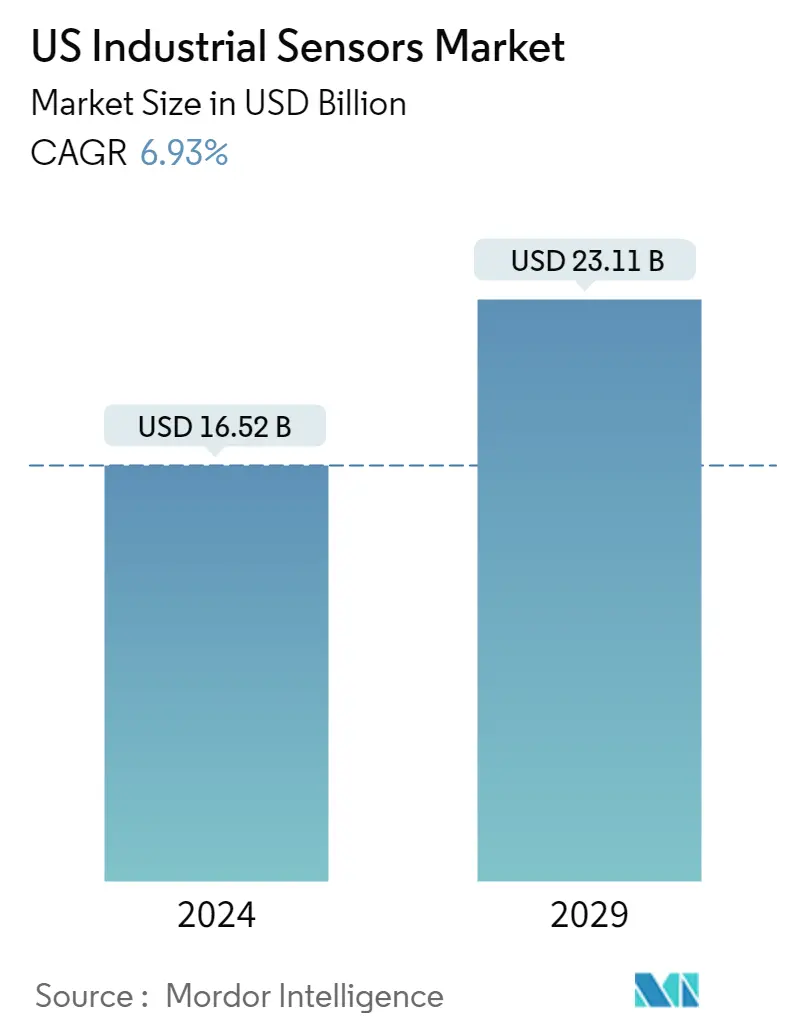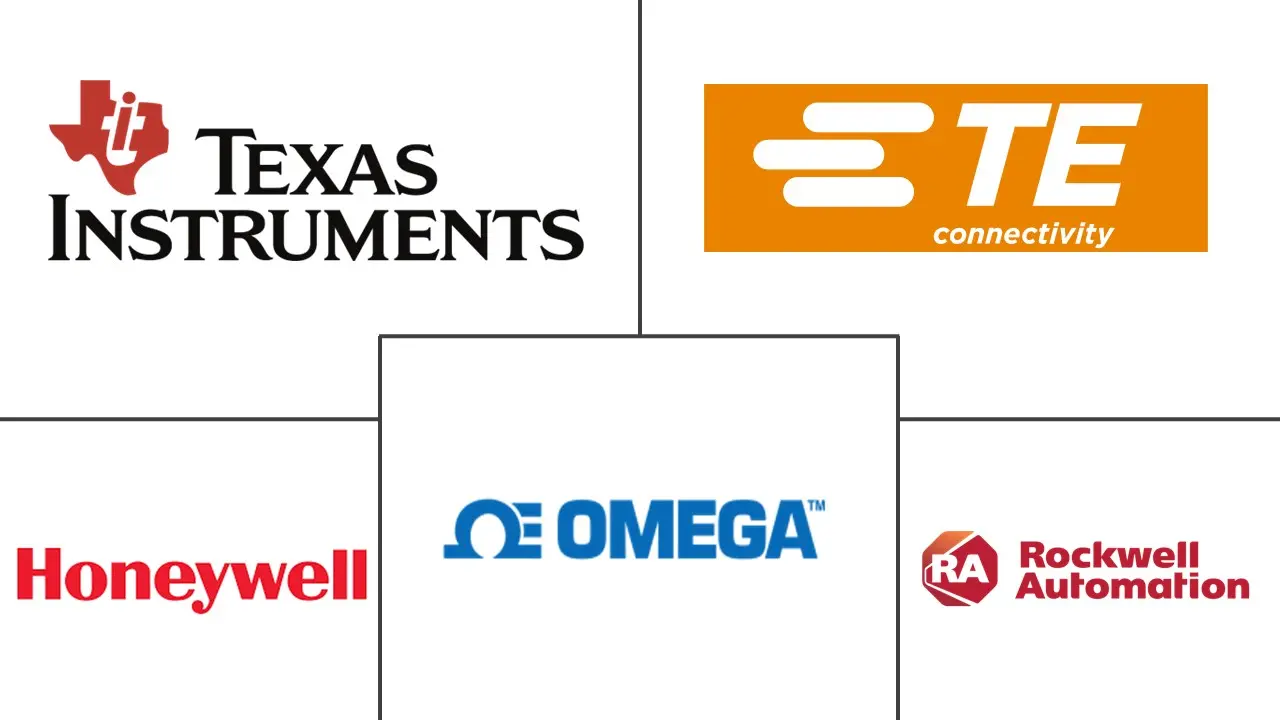Market Size of US Industrial Sensors Industry

| Study Period | 2019 - 2029 |
| Base Year For Estimation | 2023 |
| Market Size (2024) | USD 16.52 Billion |
| Market Size (2029) | USD 23.11 Billion |
| CAGR (2024 - 2029) | 6.93 % |
| Market Concentration | Low |
Major Players
*Disclaimer: Major Players sorted in no particular order |
US Industrial Sensors Market Analysis
The US Industrial Sensors Market size is estimated at USD 16.52 billion in 2024, and is expected to reach USD 23.11 billion by 2029, growing at a CAGR of 6.93% during the forecast period (2024-2029).
Industrial sensors are a crucial part of factory automation and Industry 4.0. Sensors such as motion, environmental, and vibration sensors are used to monitor equipment health, from linear or angular positioning, tilt sensing, leveling, shock, or fall detection. United States industries are positioned to augment their operations economically and demographically, serving both domestic interests and export possibilities, which will rise soon.
- An industrial sensor system is often powered by a 24V DC source, which is very different from a sensor in a consumer system that is powered by a 3V or 5V source. As a result, industrial sensor systems require additional power management to drive the sensors effectively. These use digital outputs such as IO-Link directly to a microcontroller or the wireless transceiver.
- The increasing adoption of IoT in the United States can be attributed to factors like rapid digitalization, technological advancements, government initiatives, policies, and investments aimed at promoting digital transformation and Industry 4.0. Due to Industry 4.0 and the acceptance of IoT, massive shifts in manufacturing require enterprises to adopt agile, smarter, and innovative ways to advance production with technologies that complement and augment human labor with automation and reduce industrial accidents caused by process failure. With the high adoption rate of connected devices and sensors and the enabling of M2M communication, there has been an increase in the data points generated in the manufacturing industry.
- Although the global automotive sector witnessed a recession in the past two years, the trend was also reflected in the United States. The number of sensors and sensor components increased in the sector. MEMS pressure sensors have witnessed significant adoption in the smart automotive sector in the last few years. For the same, Asystom launched a range of multi-sensor IIoT devices featuring increased autonomy.
- The multi-sensor capability has addressed the predictive maintenance needs of a wide array of industrial equipment, integrating new on-board, connected, energy-saving electronics performing in situ analysis. Apart from increased performance, these innovative products are eco-responsible and 100% upgradeable.
- Although the integration of sensors increases the industrial automation level, it incurs an additional cost, which limits the use in cost-sensitive applications. Additionally, high development costs involved in the research and development activities to manufacture new products act as a critical challenge, mainly for the cash-deficient small and medium-sized sensor manufacturers. While the cost disparity has been declining in the past few years, they still cost more. However, as productivity is crucial in several industrial settings, these sensors have been widely adopted by multiple organizations across the region. However, higher initial investment still poses a significant challenge to the market's growth.
US Industrial Sensors Industry Segmentation
Industrial sensors are devices that may sense changes in the environment and provide an output signal with respect to input or change in the environment. These sensors can sense physical input, such as light, heat, motion, moisture, pressure, or any other entity, and respond by producing an output on display or transmitting the information in electronic form for further processing.
The scope of the study includes the different types of sensors used in Industrial applications, with the prominent industries in the scope being chemicals and petrochemicals, oil and gas, water and wastewater, food and beverage, power, aerospace and military, life sciences, and other end-user industries in the United States. The study also tracks the key market parameters, underlying growth influencers, and major vendors operating in the industry, which supports the market estimations and growth rates during the forecast period. The study further analyzes the overall impact of macroeconomic trends on the ecosystem.
The United States Industrial Sensors Market is Segmented by connectivity (wired solutions, wireless solutions), by type (flow sensors, temperature sensors, level sensors, pressure sensors, gas sensors). The report offers market forecasts and size in value (USD) for all the above segments.
| By Connectivity | |
| Wired Solutions | |
| Wireless Solutions |
| By Type | ||||
| ||||
| ||||
| ||||
| ||||
| ||||
| Other Sensors |
US Industrial Sensors Market Size Summary
The US Industrial Sensors Market is poised for significant growth, driven by the increasing integration of sensors in factory automation and the broader adoption of Industry 4.0 principles. These sensors, including motion, environmental, and vibration types, play a vital role in monitoring equipment health and enhancing operational efficiency. The market is experiencing a surge in demand due to the rapid digitalization and technological advancements in the United States, supported by government initiatives and investments aimed at fostering digital transformation. The Industrial Internet of Things (IIoT) is a key driver, enabling industries to leverage data from connected devices to optimize processes, improve decision-making, and create new revenue streams. Despite the high initial costs associated with sensor integration, the benefits of increased productivity and reduced industrial accidents are encouraging widespread adoption across various sectors.
The market landscape is characterized by a diverse range of applications, from automotive to healthcare, with pressure sensors witnessing significant growth due to their critical role in monitoring system pressures across industries. Innovations such as MEMS pressure sensors and multi-sensor IIoT devices are addressing the predictive maintenance needs of industrial equipment, offering eco-responsible and upgradeable solutions. The presence of major players like TE Connectivity, Honeywell, and Siemens, along with strategic partnerships and acquisitions, is enhancing product offerings and competitive positioning. As the market continues to evolve, the focus on smart sensors and IoT integration is expected to drive further advancements, making sensors an indispensable component of modern industrial operations.
US Industrial Sensors Market Size - Table of Contents
-
1. MARKET INSIGHTS
-
1.1 Market Overview
-
1.2 Industry Attractiveness - Porter's Five Forces Analysis
-
1.2.1 Bargaining Power of Suppliers
-
1.2.2 Bargaining Power of Buyers
-
1.2.3 Threat of New Entrants
-
1.2.4 Threat of Substitutes
-
1.2.5 Degree of Competition
-
-
1.3 Industry Value Chain Analysis
-
-
2. MARKET SEGMENTATION
-
2.1 By Connectivity
-
2.1.1 Wired Solutions
-
2.1.2 Wireless Solutions
-
-
2.2 By Type
-
2.2.1 Flow Sensors
-
2.2.1.1 Market Overview
-
2.2.1.2 End-user Industry
-
-
2.2.2 Temperature Sensors
-
2.2.2.1 Market Overview
-
2.2.2.2 End-user Industry
-
-
2.2.3 Level Sensors
-
2.2.3.1 Market Overview
-
2.2.3.2 End-user Industry
-
-
2.2.4 Pressure Sensors
-
2.2.4.1 Market Overview
-
2.2.4.2 End-user Industry
-
-
2.2.5 Gas Sensors
-
2.2.5.1 Market Overview
-
2.2.5.2 End-user Industry
-
-
2.2.6 Other Sensors
-
-
US Industrial Sensors Market Size FAQs
How big is the US Industrial Sensors Market?
The US Industrial Sensors Market size is expected to reach USD 16.52 billion in 2024 and grow at a CAGR of 6.93% to reach USD 23.11 billion by 2029.
What is the current US Industrial Sensors Market size?
In 2024, the US Industrial Sensors Market size is expected to reach USD 16.52 billion.

